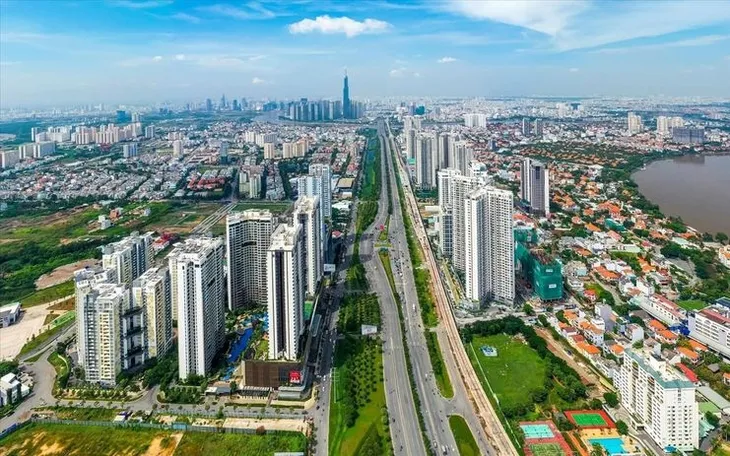25/07/2025
The increase in asking prices reflects strong, stable demand and significant growth in Hanoi’s real estate market, particularly in near-central areas.
In Q2/2025, the real estate market continued to show a price increase trend, especially in the for-sale segment. According to data from the event “Vietnam Real Estate Market Overview – H1 2025” organized by Batdongsan.com.vn, average listing prices continued to rise amid improved capital flow and gradually improving macroeconomic conditions.

Apartments Maintain Their Leading Role in the Market
In Hanoi, apartment prices have continued their upward momentum and now sit significantly higher than those in Ho Chi Minh City. In early 2023, the average apartment price in Hanoi was VND 38 million/m², 23% lower than Ho Chi Minh City’s former average of VND 47 million/m². By 2024, Hanoi had caught up, and by now (mid-2025), the average has reached VND 70 million/m²—about 11% higher than in Ho Chi Minh City. Post-merger, the average price in the newly formed Ho Chi Minh City is VND 57 million/m², 25% lower than in Hanoi.
Despite the price gap in sales, apartment rental prices have remained stable in both cities.
The rising price level clearly reflects steady demand and robust growth in the capital’s market, especially in near-central districts where synchronized infrastructure investments and large-scale urban developments are taking place.
These near-central areas are now the hotspots for apartment price increases, thanks to integrated mega-urban developments, master planning, and major infrastructure projects such as Ring Road 4, Tran Hung Dao Bridge, and Tu Lien Bridge, which shorten travel times.
While central areas still command a 20–30% price premium, near-central zones are showing superior growth potential, with abundant land, good connectivity, and appeal to both homebuyers and long-term investors.
In Q2/2025, apartments affirmed their leadership with the highest interest rate (29%), surpassing land lots (28%) and private houses (22%). This shift indicates that buyers are moving from speculative investment toward real housing needs and long-term cash-flow-driven investments.
According to a survey of 502 real estate agents, 64% stated that end-users accounted for over 40% of transactions—highlighting genuine demand as the main driver. Meanwhile, 57% of agents said over 40% of buyers were purchasing for rental purposes, showing a shift from short-term speculation to stable income-generating investments.
Notably, 46% of agents reported that short-term speculators made up less than 20% of buyers, indicating a clear decline in short-term investment sentiment. This is a positive sign of a healthier, more sustainable market.
Apartment market activity showed a clear rebound starting in June 2025. Compared to April 2025, apartment interest increased by 11% in the new Ho Chi Minh City and 9% in the old area. Listing volumes also rose by 12%, signaling recovering supply aligned with growing demand.
According to Mr. Dinh Minh Tuan, Southern Regional Director at Batdongsan.com.vn, increased attention to the new Ho Chi Minh City stems from effective population decentralization, updated administrative planning, and the emergence of satellite economic-service hubs. These factors form a solid foundation to attract medium- and long-term investment flows.
In addition to local demand, Ho Chi Minh City remains attractive to northern investors. In Q2/2025, 73% of apartment searches in the city were from locals, indicating strong internal demand.
Importantly, northern capital flows into Ho Chi Minh City rose significantly—from 44% (Q2/2024) to 61% (Q2/2025). This coincided with the point when Hanoi’s apartment prices surpassed those of HCMC, prompting northern investors to view HCMC as a market with better growth potential.
Land Lots Cool Down, Enter Cautious Phase
After a strong growth period earlier in the year, the land lot market cooled significantly in Q2/2025 in both interest and supply. The primary reasons include real estate tax policy discussions, tariff fluctuations, and the extended holiday in late April–early May.
Data from Batdongsan.com.vn shows that, compared to March, land lot interest in June dropped sharply: down 47% in Hanoi, 28% in former HCMC, and 33% in other areas. Listings also fell: down 15% in Hanoi, 9% in old HCMC, and 3% elsewhere. This signals a cautious sentiment from both buyers and sellers amid rising holding costs and policy uncertainties.
Land lot interest in Q2/2025 showed regional differences. In the North, interest was widely spread—concentrated in economically strong provinces such as Hai Phong, Bac Ninh, and Hung Yen. In the South, activity remained focused around the new HCMC area.
In summary, the first half of 2025 marked a clear correction in the land lot market following an early-year surge. Regional divergence is becoming clearer—with the North leading in price increases while the South attracts more cautious capital. Infrastructure and planning remain the key factors determining long-term investment potential and growth strategies.


 Zalo
Zalo Webchat
Webchat